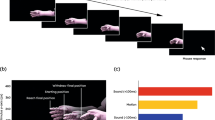Summary
A comparison was made of electrocutaneous magnitude estimation data across two experiments with contextual differences not involving stimulus parameters, such as number and range of stimuli and relative position of the standard in the stimulus range. The data were fitted by 2-parameter linear, log-linear and power functions. When the data are fitted by either linear or log-linear equations, both intercept and slope parameters are significantly affected by the different contextual factors. When the data are fitted by a power function, however, only the intercept is altered; the slope remains invariant despite contextual changes introduced in the second experiment.
Although the empirically derived psychophysical power law has been applied to magnitude estimation data for all other sensory modalities, its application to electrocutaneous stimuli has been less successful.
Similar content being viewed by others
References
Babkoff, H., Bergman, Y., Brandeis, R.: Response probability and response latency to threshold electrocutaneous stimuli. Percept. Psychophys. 15, 417–424 (1974)
Babkoff, H., Brandeis, R., Bergman, Y.: Partial integration of single electrocutaneous pulses. Percept. Psychophys. 17, 285–292 (1975)
Beck, C., Rosner, B. S.: Magnitude scales and somatic evoked potentials to percutaneous electrical stimulation. Psychophysiol. and Behav. 3, 947–983 (1968)
Bujas, Z., Szabo, S., Kovacic, M., Rohacek, A.: Sensory scales for electrical stimuli in three sense modalities. Acta Instituti Psychologici, Univ. Zagreb 75, 17–23 (1975)
Duda, P. D.: Tests of the psychological meaning of the power law. J. Exp. Psychol.: Human Perception and Performance, 104, 188–194 (1975)
Luce, R. D.: What sort of measurement is psychophysical measurement. Am Psychol. 27, 96–106 (1972)
McCallum, P., Goldberg, H.: Magnitude scales for electrocutaneous stimulation. Percept. Psychophys. 17, 75–78 (1975)
Poulton, E. C.: The new psychophysics: Six models for magnitude estimation. Psychol. Bull. 69, 1–19 (1968)
Rollman, G. B.: Electrocutaneous stimulation. In: Geldard, F. (Ed.): Cutaneous Communication Systems and Devices. Pp. 38–51. Texas: The Psychonomic Society, Inc. 1974
Rosner, B. S., Goff, W. R.: Electrical responses of the nervous system and subjective scales of intensity. In: Neff, W. D. (Ed.): Contributions to Sensory Physiology, Vol. 2, pp. 169–221. New York: Academic Press 1967
Sternbach, R. A., Tursky, B.: On the psychophysical power function in electric shock. Psychonomic Sci. 1, 217–218 (1964)
Stevens, S. S., Carton, A. S., Shickman, G. M.: A scale of apparent intensity of electric shock. J. Exp. Psychol. 56, 328–334 (1958)
Author information
Authors and Affiliations
Rights and permissions
About this article
Cite this article
Babkoff, H. Magnitude estimation of short electrocutaneous pulses. Psychol. Res 39, 39–49 (1976). https://doi.org/10.1007/BF00308944
Received:
Issue Date:
DOI: https://doi.org/10.1007/BF00308944




